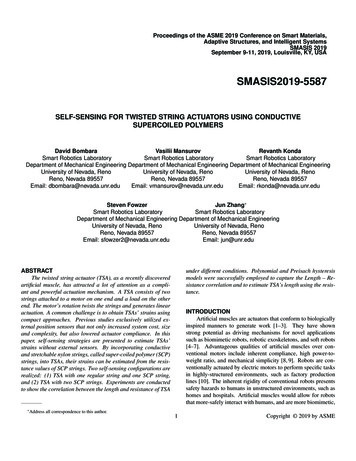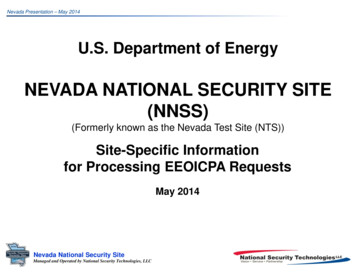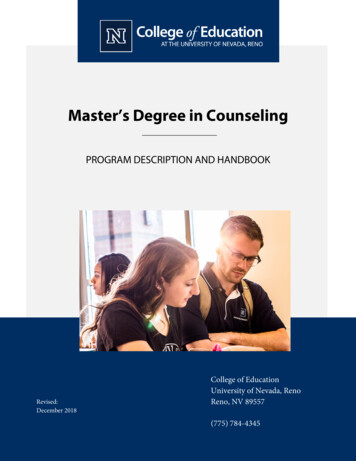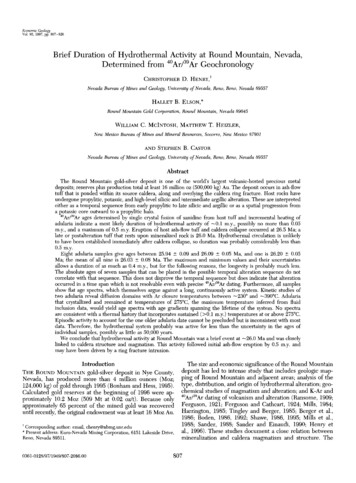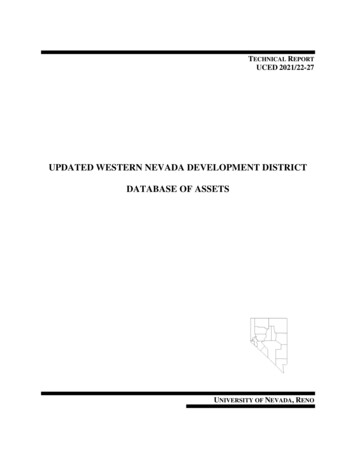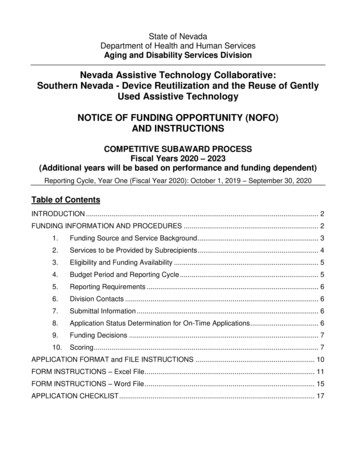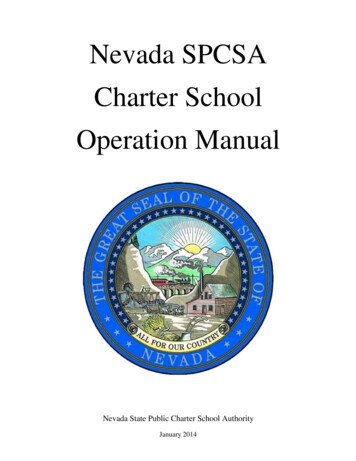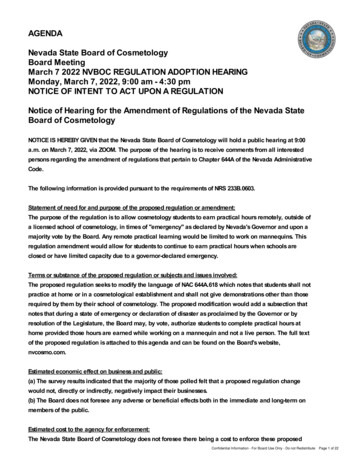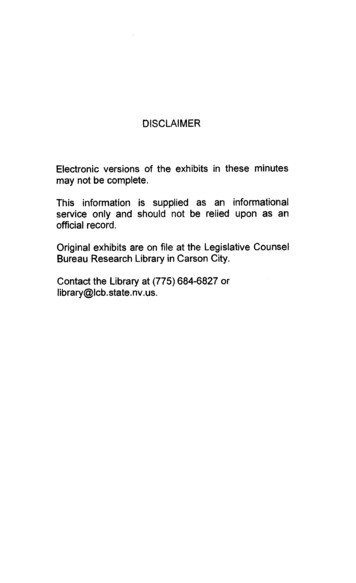
Transcription
DISCLAIMERElectronic versions of the exhibits in these minutesmay not be complete.This information is supplied as an informationalservice only and should not be relied upon as anofficial record.Original exhibits are on file at the Legislative CounselBureau Research Library in Carson City.Contact the Library at (775) 684-6827 orlibrary@lcb.state.nv.us.
A PUBLIC PRIVATE PARTNERSHIP INCLUDING:ASSEMBLYWOMAN BARBARA E. BUCKLEY, LAS VEGASU.S. SENATOR HARRY REID, LAS VEGASMAYOR OSCAR B GOODMAN, LAS VEGASCOUNCILMAN STEVE WOLFSONSTATE OF NEVADA HOUSING DIVISIONTHE CITY OF LAS VEGASAARP NEVADA STATE OFFICEAFFIRMATIVE INVESTMENTS, INC.AFFORDABLE HOUSING RESOURCE COUNCIL RENOClTlBANK (WEST), F.S.B.DEPARTMENT OF HUMAN RESOURCES STATE OF NEVADAFANNIE MAE NEVADA PARTNERSHIP OFFICEFEDERAL HOME LOAN BANK OF SAN FRANCISCOHARRAH'S ENTERTAINMENT, INC.MMA FINANCIAL. LLCNEVADA STATE BANKSOUTHERN CALIFORNIA PRESBYTERIAN HOMEUNIVERSITY OF NEVADA COOPEWrIVE EXTENSIONWELLS FARGOORIGINALS ARE ON FLLE AT THE LEGISLATIVECOUNSEL BUREAU RESEARCH LIBRARY-SUBCOMMITTEEDATE:-SUBM:IB-ir w0IBIT '3E4-E
The Teamwork that Made this HappenNevada Assemblywoman Barbara E. BuckleyAssemblywoman Buckley spearheaded the Silver Sky project. A long time advocate forseniors and affordable housing, Assemblywoman Buckley was able to bring the right players tothe table to make the Silver Sky project possible. The collaborations she developed throughthis project will benefit future efforts to develop affordable assisted living in Nevada andelsewhere in the country.The City of Las VegasMayor Oscar B. GoodmanCouncilman Steve WolfsonOrlando Sanchez, Director, Neighborhood Services DepartmentFaye Johnson, Manager, Neighborhood Development DivisionSue Prescott, Supervisor, Neighborhood Development DivisionThe City assisted in this project from the time of inception. They located the land they thoughtwould be best for the project and worked with United States Senator Harry Reid's office on thelanguage of the bill to be introduced. They earmarked 1 million in HOME funds towards theproject. They helped coordinate a bus for the executive committee's tour of facilities, and flewtheir staff to California to see the great projects of Southern California Presbyterian Homes,which led to a positive recommendation towards them being selected as the operator of thisproject.U.S. Senator Harry ReidIt took an act of Congress to develop this project and Senator Harry Reid made it happen.Senator Reid worked tirelessly to ensure the proper provisions were in place to transfer landheld by the Bureau of Land Management to the City of Las Vegas, Nevada, for thedevelopment of affordable housing.Hurrah's Enterrainment, Inc.Jan Jones, Senior Vice President of Communications and Government AffairsJulie Murray, Director of Community RelationsIn addition to making a historic financial contribution to the Silver Sky Project,Harrah's Entertainment offered support to the MALAC Executive Committee andhosted meetings of the entire MALAC. Harrah's also pledged to have its employees volunteerat the site to visit and offer activities on site for the seniors. Julie Murray serves as co-chair ofthe MALAC Executive Committee.
AARPCarla Sloan, Nevada State DirectorThe AARP advocated for quality affordable assisted living in Nevada, and helped to bringthe issues related to assisted living to the Nevada Legislature. The AARP supported theSilver Sky project and offered technical support and research assistance to keep the project onthe cutting edge of assisted living development. Carla Slown serves as co-chair of theMALAC Executive Committee.State of NevadaMichael J . Willden, Director, Department of Human Resources (DHR)Mary Liveratti, Deputy Director, DHRCharles Duarte, Administrator, Division of Health Care Financing and Policy, DHRCarol Sala, Administrator, Aging Services Division, DHRPamela Graham, Chief, Bureau of Licensure and Certification, Health Division, DHRThe Department of Human Resources worked with MALAC throughout the development ofSilver Sky. When challenges arose, the DHR staff worked with MALAC to devise alternativesand solutions to keep the project moving forward. To address tax credit investor concerns,staff developed an innovative way to ensure that investors felt satisfied about the feasibility ofthe project, by pledging tobacco settlement dollars to guarantee that services would be offeredon site.Charles L. Horsey, Administrator, Housing Division, Department of Business and IndustryThe Housing Division was one of the strongest supporters of the project from its inception.They conducted community hearings to ensure that affordable assisted living projects wereconsidered a high community need in the awarding of financing of projects. They awardedcritical funding to the project to ensure it proceeded. They offered technical advice andopinions on the project as well as on issues relating to assisted living generally.This project would not have been possible without the collaborative efforts of the DHR and theHousing Division.
IntroductionSilver Sky Assisted Living Residence is a model, affordable, nonprofit assisted living facilityunder development in Clark County, Nevada. Silver Sky, to be located in the Summerlin areaof Las Vegas, involves the construction of 84 one-bedroom and six two-bedroomaccessibleladaptable apartments. Silver Sky includes substantial community service space toallow for the provision of assisted living services. Amenities include a dining room andcommercial grade kitchen, a recreation room, lounges, exam and wellness space, beauty shop,laundry rooms, secure and landscaped grounds, courtyards, and porches. An adjacent 80-unitindependent elderly development is also planned for the ten-acre site, to create a continuum ofcare campus designed to create a community and to prevent traumatic moves for seniors. Thispubliclprivate venture will address the shortage of affordable assisted living and services forlow-income frail elders by providing them with access to a quality living environment wherethey can age in place.The Model Assisted Living Advisory Committee (MALAC) was created in 2002 to develop thefacility. The MALAC consists of more than 60 individuals who represent public and privateaffordable housing and senior advocates and organizations throughout the State of Nevada.The objectives for MALAC in the development of the Silver Sky Assisted Living Projectincluded:1.Verifying the need for such a facility through the performancelreview of a marketanalysis;2.Acquiring land and creating a financing mechanism that would reduce the initial cost ofpre-developing, constructing, and operating the project;3.Coordinating federal, state, and local government organizations and requirementsrelated to the definition, licensure, and operation of assisted living facilities;4.Maximizing the use of federal, state, and local resources available to maintain theaffordability of the project by providing for the services, and room-and-board costsnecessary for each intended resident; and5.Proposing policy recommendations that will increase the development of future projectssuch as Silver Sky.The Committee selected a Chairperson and an Executive Committee. The ExecutiveCommittee selected a Development Team and participated on this team as appropriate. Thefollowing members served on the Executive Committee and Development Team of MALAC:
Executive CommitteeAssemblywoman Barbara E. Buckley , Nevada State Assembly, ChairwomanClaudia Collins, Associate Professor, University of Nevada Cooperative ExtensionBruce McAnnany, Aging Services Division, Department of Human Resources (DHR)Julie Murray, Consultant, Harrah's EntertainmentCharlene Peterson, Director, Fannie MaeOrlando Sanchez, Director, Neighborhood Services, City of Las VegasCarla Sloan, Director, AARP, Nevada State OfficeDevelopment TeamGreg Bearce, Executive Vice President, Southern California Presbyterian HomesDavid Ennis, President, Affirmative Investments, Inc.Bob Fiebleman, Executive Vice President, Nevada Housing and Neighborhood Development(HAND), Inc.Junlin Ho, Affirmative Investments, Inc.Sally Little, Vice President, Southern California Presbyterian HomesMike Mullin, Executive Director, Nevada HAND, Inc.Ernie Nielsen, Senior Law Project, Washoe County Legal Services, and President, AffordableHousing Resource CouncilJonnie Pullman, Executive Director, Affordable Housing Resource CouncilRick Salyer, Director of Residential Studio, Perlman Architects, Inc.Linda Silviera, Affirmative Investments, Inc.The MALAC Executive Committee met on a monthly basis between March 2002 andSeptember 2004. The Development Team met together with the Executive Committee andheld several meetings separately to address specific aspects of the development process.All of the meetings were based in Las Vegas and available for participation by members viateleconference.In this document, MALAC has attempted to outline the process of developing the Silver SkyAssisted Living Residence and challenges and recommendations that were encountered in aconcise manner. The five objectives summarized earlier provide the outline for the report.Additionally, an abbreviated timeline, abbreviated biographies for the development team, and alist of all MALAC members can be found at the end of this report.
The Need for Affordable Assisted Living in NevadaAssisted living provides supportive services, personalized assistance, and access to health carein addition to meeting the seniors' overall housing needs. Although the need for additionalaffordable assisted living was evident to many, MALAC sought out objective data todemonstrate the necessity of the Silver Sky project. The demographic data examined includedthe current senior population and growth expectations, senior incomes, and an assessment ofthe stock of affordable assisted living around the state, and particularly in the Clark Countyarea. Following are several highlights from various reports that were used to gathersupporting data.Based on the latest United States Census Bureau estimates, the state's population of 2.2 millionis up 12.2 percent since 2000. In addition, the Census Bureau notes that one of the greatestareas of growth is among the senior citizen population. Although Nevadans who are 85 andolder are only 1 percent of the state's total population, they showed the largest increase inpopulation growth rising 30 percent over the past three years. The Census Bureau projectionsfurther indicate there will be more than 34,000 seniors in Nevada over the age of 85 by theyear 2030.In 2003, the Housing Division, Nevada's Department of Business and Industry, commissioneda study to estimate the special-needs populations in urbanized areas of Clark andWashoe Counties and to assess their housing needs. The firm of BBC Research & Consultingproduced the study, titled "Nevada Special Needs Housing Assessment." In addition to otherspecial-needs populations the study considered persons 55 years old or older. In addition toother items, the study found that monthly rental rates for assisted living complexes rangebetween 800 and 3,900, depending on the level of care provided. Industry experts indicatethat the 800 monthly cost for care is only enough to cover room, board, and minimal care,at best. According to the report, the higher end facilities largely cater to moderate andhigh-income seniors.Another report titled "State Handbook of Economic, Demographic, and Fiscal Indicators2003," which is produced by the Public Policy Institute of AARP, indicates that a little over18 percent of seniors aged 65 to 74 and approximately 27 percent of seniors age 75 and overliving in Nevada, head households with incomes less than 15,000 amually . Many seniorsfind it difficult to afford housing and when those seniors' health begins to fail, it is even moredifficult to find affordable assisted living.Finally, the need for quality affordable assisted living services in the Las Vegas area isconfirmed by a March 2003 market study report conducted specifically for the Silver SkyAssisted Living Residence by Gerontological Services, Inc. (GSI). In addition to other items,the study indicates that few existing properties or properties in development within the marketarea offer units for very low and low-income elders. Of these, none offer private apartmentsor the package of amenities that will be available at the Silver Sky Assisted Living Residence.
Land Acquisition and Financing the ProjectSeveral resources were secured to finance the cost of planning and constructing the Silver SkyAssisted Living Residence. Among them are: acquisition of land from the Bureau of LandManagement (BLM); private donations; state funding; and granting of Low Income HousingTax Credits; HOME Funds; and the Federal Hoine Loan Bank - Affordable Housing Program.In addition, Fannie Mae and Wells Fargo each donated 5,000 for certain overhead costsassociated with the development of the Silver Sky Project.Land AcquisitionThe Southern Nevada Public Land Management Act of 1998, provided for the privatization ofpublic land administered by the Bureau of Land Management (BLM) in the Las Vegas Valleyto make land available for community growth. The Act authorized the sale of public landscompetitively on the open market, or their conveyance to local governments at their request atlow, or no-cost for public uses such as schools, parks, police and fire stations, libraries, andother public uses. In April of 2002, recognizing the potential opportunity to secure BLM landfor the project, MALAC identified two prospective sites for the construction of Silver Sky.After further assessment a determination was made to pursue development of a specific BLMland site.To allow for the transfer of land, United States Senator Harry Reid introducedSenate Bill 2612. The provisions of this measure were rolled into House of RepresentativesBill 5200. As a result of his effort, the U.S. Congress passed the Clark County Conservationof Public Lands and Natural Resources Act of 2002 (Public Law 107-282). In addition toother items, this measure directed the conveyance of certain Federal land to the City ofLas Vegas, Nevada, for the development of affordable housing or other related purposes.Through this measure, affordable housing was declared a public purpose in terms of obtainingsuch land free, or below market value. However, due to a clerical error in the originalmeasure, the land site was unable to be transferred to the City of Las Vegas. To address thisproblem, Senator Harry Reid offered an amendment to Interior Department AppropriationsAct, 2004 (Public Law 108-108) to allow for the conveyance of land to the City of Las Vegas,for the construction of affordable housing for seniors. The land transfer authorized by thislegislation is the first time in the country BLM land has ever been used for assisted livinghousing.Private DonationsIn 2002, Harrah's Entertainment, a geographically diversified casino company, confirmed itsdedication to the project through a financial contribution of 800,000 over a three-year period.As the Affordable Housing Resource Council (AHRC), the nonprofit developer for the project,began predevelopment and established a firmer developmental budget and project timeline, thefirst installment of 280,667 was requested from Harrah's in December 2003. This first
installment served as a "start up gift" and helped to secure additional matching gifts and funding.The second and final installment is scheduled to take place before the facility opens.In appreciation for such a generous donation, the recreational center on the Silver Sky campuswill be named in honor of Harrah's Entertainment. This honor is further merited by Harrah'scommitment to coordinate and provide volunteers at Silver Sky.Account for Low-Income HousingThe Housing Division, Nevada's Department of Business and Industry, allocatedapproximately 800,000 ( 400,000 per fiscal year) from the Account for Low-Income Housing(Trust Fund), for use on the Silver Sky project. The Trust Fund is a state-funded program foraffordable housing in which funds are allocated by formula to participating jurisdictions (stateand local governments) to expand and improve the supply of rental housing through newconstruction and rehabilitation of multi-family projects. Trust funds may also be used toprovide financing for down payment assistance, homeowner rehabilitation of single familyresidences, and to provide emergency assistance to families who are in danger of becominghomeless. Funding is supported with a real property transfer tax of 10 cents for each 500 ofvalue, or fraction thereof. All funds allocated must be used to benefit individuals and familieswhose incomes do not exceed 60 percent of the area median income, as defined by theU. S. Department of Housing and Urban Development (HUD) .Low Income Housing Tax CreditsThe Internal Revenue Service (IRS) Low Income Housing Tax Credits Program (LIHTC)provides another source of funding for the Silver Sky project. The model project was awarded 750,000 in Low Income Housing Tax Credits for the April 9, 2004, funding cycle.Following this allocation the Housing Division awarded an additional 65,656 in tax credits !othe project. In May 2005, the project plans to seek an additional 105,344 in tax credits toassist in dealing with increased construction costs.The LIHTC program was created by the Tax Reform Act of 1986 and provides federal taxincentives for the construction or rehabilitation of rental housing units occupied by low-incomehouseholds. The program provides the owner with a tax credit of 9 percent of the qualifiedcost of the project to offset federal income tax for a ten-year period. This federal programenables low-income housing developers to raise equity from investors and thereby lower theirtotal development debt and reduce the monthly rents needed to repay that debt. State housingagencies award the limited supply of tax credits to developers who are chosen on a competitivebasis during publicized application cycles. In Nevada, the Housing Division, Department ofBusiness and Industry, administers the Tax Credit Program.Investors who acquire the LIHTC are always concerned about the viability and sustainability ofan investment project and that the project complies with all federal laws and regulations for theduration of the investment. Additionally, special-needs projects such as Silver Sky differ from
traditional affordable housing ventures, in that they receive funding for providing shelter, andspecific services. Considering this fact, the operating budget for Silver Sky is based on theassumption that funding from the Medicaid home and community-based waiver program willpay for assisted living services for up to 54 of the 90 units for very low income seniors. Theother 36 units will have residents with sufficient funds and assets to cover the monthly rent andservice costs. This scenario is of concern to tax credit investors, because the project dependsgreatly on the availability of waiver slots. To provide some assurance to investors regardingthis funding, MALAC attempted to receive from the state's DHR a "guarantee" that these slotswould be available. Based on the DHR staffs interpretation of federal guidelines, the stateindicated they were not able to "guarantee" a certain number of Medicaid home andcommunity-based waiver slots to a specific facility.Administration of the DHR was keenly aware of the distinctiveness of the project as well as theconcerns expressed by potential tax credit financiers, and developed an alternate strategy toprovide such an assurance. To satisfy tax credit investors concerns, the DHR agreed to useIndependent Living Grant, Tobacco Settlement Funds to ensure the availability of funding forthe Medicaid home and community-based waiver slots at Silver Sky.HOME FundsThe City of Las Vegas awarded a grant of 1 million in HUD HOME funds to the Silver Skyproject in 2003. HOME is the largest federal block grant to state and local governmentsdesigned exclusively to create affordable housing for low-income households. HOMEprovides formula grants to states and localities that communities use, often in partnership withlocal nonprofit groups, to fund a wide range of activities that build, buy, andlor rehabilitateaffordable housing for rent, or homeownership, or provide direct rental assistance tolow-income people.The Federal Home Loan Bank - Affordable Housing ProgamThe Federal Home Loan Bank of San Francisco is privately owned by its members, whichinclude commercial banks, savings institutions, credit unions, thrift and loan companies, andinsurance companies headquartered in Arizona, California, and Nevada. The Bank is part of anetwork of 12 regional Federal Home Loan Banks chartered by Congress in 1932 to providelow-cost credit to residential housing lenders. The bank meets the borrowing needs ofcommunities by providing wholesale credit products and services to member financialinstitutions. The bank also offers four grant programs that help very low- to moderate-incomefamilies and individuals obtain quality rental housing or become homeowners and fundseconomic development projects.Silver Sky received 550,000 in grant funds through the Affordable Housing Program (AHP).The AHP facilitates the development of affordable rental housing and homeownershipopportunities for very low-, low-, and moderate-income households. Through a competitiveapplication process, the bank provides grants or subsidized interest rates on advances to
members to finance their affordable housing initiatives. The member banks that havesponsored Silver Sky during the course of this grant are Wells Fargo, Citibank, and currentlyNevada State Bank.Coordination of Federal, State, and Local Government OrganizationsThe unique funding for the project increased the necessity to coordinate federal, state, andlocal government organizations who develop or support assisted living and affordable housing.This section briefly outlines the unique challenges this project overcame by developing aunique partnership between MALAC and local government entities to move the projectforward.When the project began, it became apparent that advocates for affordable housing andassisted-living shared the same goal; however, they did not have a very strongunderstanding of each others field.To overcome this challenge, Nevada StateAssemblywoman Barbara E. Buckley; U.S. Senator Harry Reid; Housing Division,Department of Business and Industry; DHR; AARP; and Harrah's Entertainment sponsoredseveral educational workshops covering the development of affordable housing and assistedliving. These workshops included discussions surrounding the architectural design needs ofassisted living facilities, the need to ensure the availability of adequate supportive services,alternative financing schemes for construction, and utilizing Medicaid waivers as well as otherstate and local resources to provide assisted-living services. These workshops furtherdemonstrated to MALAC, the level of coordination necessary to successfully develop SilverSky.To coordinate certain funding timelines and to work on specific issues necessary to proceedwith Silver Sky, MALAC selected an Executive Committee. The Executive Committee,chaired by Assemblywoman Buckley, advised, supported, and monitored the nonprofitdevelopment team responsible for making Silver Sky a reality. The Executive Committeeworked diligently to review Nevada's laws and regulations to determine barriers that mightexist in creating affordable assisted living. One of the first concerns expressed related to thelack of a definition in Nevada Revised Statutes for the term "assisted living." Senior advocatesindicated that without a definition, consumers (primarily seniors and their families) are not ableto make informed decisions regarding the type of care they should expect to receive asresidents of such a facility.To address this problem, Assemblywoman Buckley introduced legislation during the2003 Nevada Legislative Session to require the State Board of Health to adopt separateregulations governing the licensing and operation of residential facilities for groups thatprovide assisted living services. Additionally, the measure prohibited such facilities fromclaiming that they provide "assisted living services" unless certain designated criteria are met.In addition to other items, the criteria established were based on seven core principles thatwere developed by the National Assisted-Living Work Group. The seven items are:
1.The facility is designed to create a residential environment that actively supports andpromotes each resident's quality of life and right to privacy;2.The facility is committed to offering high-quality supportive services that are developedby the facility in collaboration with the resident to meet the resident's individual needs;3.The facility provides a variety of creative and innovative services that emphasize theparticular needs of each individual resident and his personal choice of lifestyle;4.The operation of the facility and its interaction with its residents supports, to themaximum extent possible, each resident's need for autonomy and the right to makedecisions regarding his own life;5.The operation of the facility is designed to foster a social climate that allows theresident to develop and maintain personal relationships with fellow residents and withpersons in the general community;6.The facility is designed for and is operated in a manner which minimizes the need forits residents to move out of the facility as their respective physical and mentalconditions change over time; and7.The facility is operated in such a manner as to foster a culture that provides ahigh-quality environment for the residents, their families, the staff, any volunteers, andthe community at large.The legislation unanimously passed both houses of the Nevada Legislature.Another policy item the Executive Committee brought forth was the limits in the number ofhome and community-based waiver slots available through Medicaid for seniors who mightbenefit from assisted living services. To address this problem, Assemblywoman Buckleyworked during the 2003 Legislative Session to increase the number of waiver slots availablefor this purpose.The Executive Committee included representatives from the Neighborhood ServicesDepartment, City of Las Vegas. This greatly assisted MALAC's effort to monitor the transferof BLM property as well as the planning and development process. The City provided weeklyupdates on the planning process to inform MALAC of upcoming deadlines and planningmeetings. Finally, the Executive Committee kept the lines of communication open between theDepartment of Business and Industry and the Department of Human Resources to ensure thehousing and service programs remained coordinated.
Funding for Assisted Living Services, Room and BoardAn ongoing challenge for affordable assisted living is discovering innovative methods offunding the needs of residents. As previously mentioned, it is expected that the majority of theresidents of Silver Sky will be Medicaid eligible. However, Medicaid is only a part of the planto cover the expenses of residents. Medicaid does not cover all of the services frequentlyneeded by seniors nor does it cover room and board. Following is an outline of Medicaid andother programs MALAC is considering to fund Assisted Living Services, and room and boardcosts.Funding Assisted Living ServicesMedicaid is a state-administered program that makes health care services available tolow-income persons who are aged, blind, or disabled and to women and children.The program is financed through a combination of money from the State General Fund, localgovernments, and the federal government. It is the largest low-income health care program inthe state. The federal government provides matching funds, known as Federal MedicalAssistance Percentage, or FMAP, to support state-administered Medicaid medical services.Up until the early 1980's, the Medicaid program required that states provide care only inskilled nursing homes and only to those of very low income. Changes over the last 20 yearshave placed more emphasis on serving seniors who need the assistance a nursing home hastraditionally provided, in a less restrictive environment (i.e., in a private home or incommunity residential settings). To allow for this type of care, Medicaid permits states torequest a waiver of certain basic rules that apply to Medicaid State Plan programs.The Medicaid home and community-based waiver (1915(c) Waiver) is the waiver utilized inNevada to cover personal care services such as those offered at Silver Sky. Nationally, thistype of waiver permits seven services to be provided: case management; homemaker; homehealth aide services; personal care; adult day health; habilitation; and respite care.In Nevada, the Medicaid waiver program for reimbursing assisted living facilities is based onan established system of tiered rates which takes into account acuity levels. Eligible seniorsare given a level of care classification, and rates are provided based on that classification.There are three levels of care.Intermediate Care Level 1 is the lowest level of care and provides basic assistance interms of cueing the individual to remind him or her to perform certain activities of dailyliving (i.e., prompts to get dressed, take a shower, take medication, etc.) and assistingthem in the performance of those activities as necessary.Intermediate Care Level 2 covers individuals who require more cueing or reminders,these individuals necessitate more support in performing certain activities of daily livingon a consistent basis.
Intermediate Care Level 3 is a level of care for individuals who require extensive handson assistance, and receive the highest level of care within the intermediate, not skilled,
Silver Sky Assisted Living Residence is a model, affordable, nonprofit assisted living facility under development in Clark County, Nevada. Silver Sky, to be located in the Summerlin area of Las Vegas, involves the construction of 84 one-bedroom and six two-bedroom accessibleladaptable apartments.

